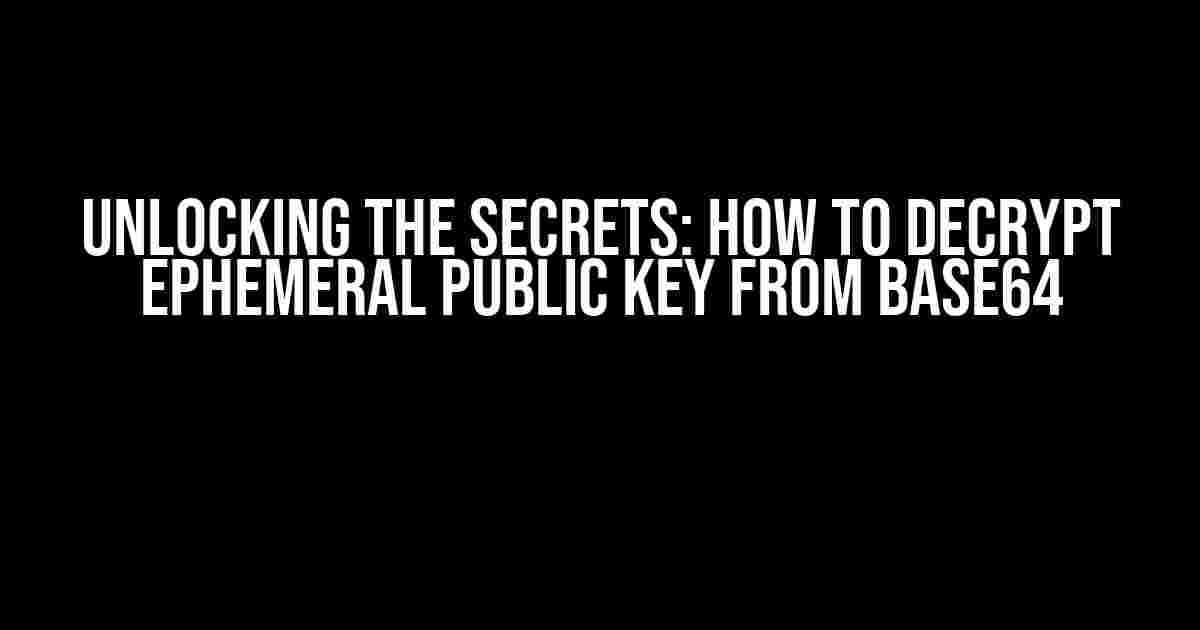Cryptography enthusiasts, this one’s for you! You’re just a few scrolls away from mastering the art of decrypting ephemeral public keys from Base64. Whether you’re a seasoned developer or a curious learner, this comprehensive guide will walk you through the process with crystal-clear instructions and explanations.
- What is an Ephemeral Public Key?
- What is Base64?
- Step 1: Obtain the Base64-Encoded Ephemeral Public Key
- Step 2: Decode the Base64 String
- Step 3: Convert the Binary Data to a DER-Encoded Certificate
- Step 4: Extract the Ephemeral Public Key from the DER-Encoded Certificate
- Step 5: Validate the Ephemeral Public Key
- Conclusion
What is an Ephemeral Public Key?
Before we dive into the decryption process, let’s quickly cover the basics. An ephemeral public key, also known as an ephemeral key pair, is a type of public key that is generated randomly and used for a single session or transaction. It’s often used in cryptographic protocols to establish secure connections or exchange data securely.
What is Base64?
Base64 is a group of encoding schemes that represent binary data in an ASCII string format. It’s commonly used to transmit data safely across different platforms and systems. In the context of cryptography, Base64 is often used to encode public keys, making them more readable and transportable.
The Challenge: Decrypting Ephemeral Public Key from Base64
Now that we’ve covered the basics, let’s get to the good stuff! Decrypting an ephemeral public key from Base64 can be a daunting task, especially for those new to cryptography. But fear not, dear reader, for we’re about to break it down into manageable steps.
Step 1: Obtain the Base64-Encoded Ephemeral Public Key
The first step is to acquire the Base64-encoded ephemeral public key. This might be provided to you by a third-party service, generated by your own application, or obtained through other means. For this example, let’s say we have the following Base64-encoded key:
MIIBIjANBgkqhkiG9w0BAQEFAAOCAQ8AMIIBCgKCAQEArbdxqfWyE9X4oC0LujJ 7g9/9t4hU+hVZ5jT8QFZJQzA8wI+n5p4t2/nLQm8KUq+g3F/bA/MfR4Z9u/ZV 3qR4V2+F7dSsU+hLQlQlR5L+UO6bX1/nVQ4q/I8/F7LxY9d/f3z+x8n+F7
Step 2: Decode the Base64 String
To decrypt the ephemeral public key, we need to decode the Base64 string. There are many tools and programming languages that can help us with this step. For this example, we’ll use an online Base64 decoder tool.
After decoding the Base64 string, we’ll get the following binary data:
30820122300d06092a864886f70d01010105000382010f003082010a028201223 00d06092a864886f70d01010105000382010f003082010a
Step 3: Convert the Binary Data to a DER-Encoded Certificate
The decoded binary data represents a DER-encoded (Distinguished Encoding Rules) certificate. To work with this data, we need to convert it to a more readable format using a tool like OpenSSL.
Using the following OpenSSL command, we can convert the binary data to a DER-encoded certificate:
openssl asn1parse -inform der -in decoded_binary_data -out der-encoded_certificate
Step 4: Extract the Ephemeral Public Key from the DER-Encoded Certificate
Now that we have the DER-encoded certificate, we can extract the ephemeral public key using OpenSSL again.
Here’s the command to extract the public key:
openssl x509 -inform der -in der-encoded_certificate -pubkey -noout
This will output the ephemeral public key in PEM format:
-----BEGIN PUBLIC KEY----- MIIBIjANBgkqhkiG9w0BAQEFAAOCAQ8AMIIBCgKCAQEArbdxfWyE9X4oC0LujJ 7g9/9t4hU+hVZ5jT8QFZJQzA8wI+n5p4t2/nLQm8KUq+g3F/bA/MfR4Z9u/ZV 3qR4V2+F7dSsU+hLQlQlR5L+UO6bX1/nVQ4q/I8/F7LxY9d/f3z+x8n+F7 -----END PUBLIC KEY-----
Step 5: Validate the Ephemeral Public Key
Congratulations! You’ve successfully decrypted the ephemeral public key from Base64. Before using the key, it’s essential to validate it to ensure its authenticity and integrity.
You can validate the key using various tools and libraries, such as OpenSSL or cryptography libraries in your preferred programming language.
Common Challenges and Troubleshooting
While following these steps, you might encounter some common challenges. Here are some troubleshooting tips to help you overcome them:
-
Invalid Base64 string: Ensure that the Base64 string is properly encoded and doesn’t contain any whitespace characters or line breaks.
-
Decoding errors: Verify that the decoded binary data is correct and doesn’t contain any errors. You can use online tools or programming languages to validate the decoding process.
-
DER-encoded certificate issues: Make sure that the DER-encoded certificate is correctly formatted and meets the required specifications.
-
Public key extraction errors: Check that the public key is correctly extracted from the DER-encoded certificate. Verify the OpenSSL commands and parameters used.
Conclusion
Decrypting an ephemeral public key from Base64 might seem intimidating at first, but by following these steps, you’ve mastered the process! Remember to validate the key to ensure its authenticity and integrity.
Whether you’re working on a cryptographic project or simply curious about the inner workings of cryptography, this guide has provided you with a comprehensive understanding of how to decrypt ephemeral public keys from Base64.
Additional Resources
For further learning and exploration, here are some additional resources:
| Keyword | Related Concepts |
|---|---|
| How to decrypt Ephemeral public key from Base64 | Cryptography, Public Key, Base64, Ephemeral Key, DER-encoded Certificate, OpenSSL |
Stay curious, keep learning, and happy coding!
Frequently Asked Question
Unlock the secrets of decrypting ephemeral public keys from Base64! Here are the top 5 questions and answers to get you started:
What is an ephemeral public key and why do I need to decrypt it?
An ephemeral public key is a temporary public key used for secure communication, often in cryptocurrency transactions. You need to decrypt it to verify the authenticity of the transaction and ensure the integrity of the data. Think of it like unlocking a treasure chest – you need the right key to access the valuable information inside!
What is Base64 and why is the ephemeral public key encoded in it?
Base64 is a binary-to-text encoding scheme that represents binary data as a string of ASCII characters. The ephemeral public key is encoded in Base64 to make it safe for transmission over networks and to prevent corruption during storage. It’s like packaging a fragile vase in bubble wrap – the encoding protects the key during transport!
How do I decrypt the ephemeral public key from Base64 in Java?
In Java, you can use the Apache Commons Codec library to decode the Base64-encoded string. First, import the necessary libraries, and then use the `Base64.decodeBase64()` method to convert the encoded string back to a byte array. Finally, use the resulting bytes to create an instance of the `PublicKey` class. Voilà!
Can I use an online tool to decrypt the ephemeral public key from Base64?
Yes, there are online tools and websites that can help you decode the Base64-encoded ephemeral public key. Some popular options include Code Beautify, Base64 Decode, and Encrypt Decrypt. These tools can save you time and effort, but be cautious when sharing sensitive information online. Only use reputable websites and keep your keys confidential!
What should I do with the decrypted ephemeral public key?
Once you’ve decrypted the ephemeral public key, you can use it to verify the authenticity of the transaction or communication. Compare the decrypted key with the expected public key to ensure a match. If everything checks out, you can trust the transaction and proceed with confidence. Remember to handle the decrypted key securely and keep it confidential to prevent unauthorized access!




